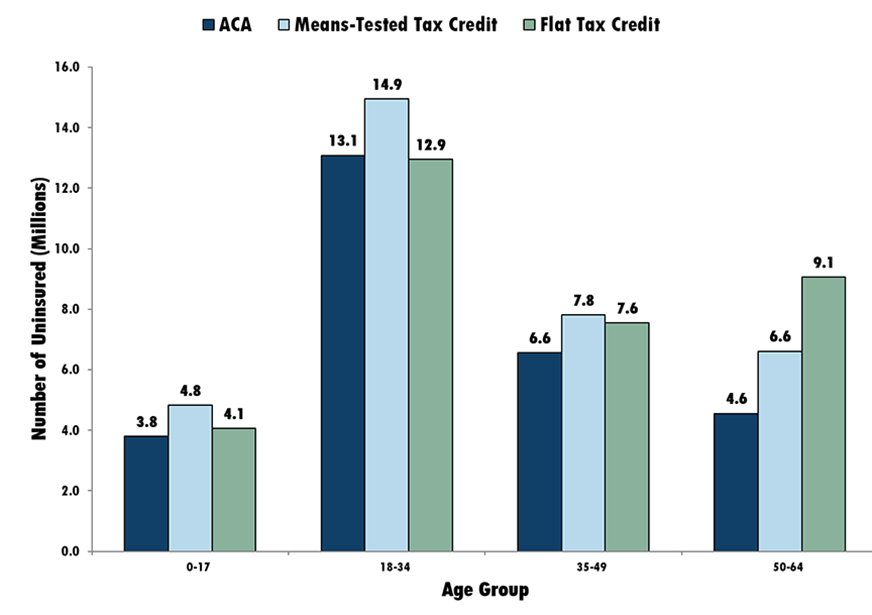Under the Affordable Care Act (ACA), tax credits for purchasing health insurance in the marketplaces are designed to limit enrollees’ premium contributions to a percentage of their income.1 Critics who want to repeal and replace the law have advanced a “premium-support” model, in which tax credits are fixed amounts for enrollees regardless of their premium costs. We have conducted an analysis that indicates that these premium-support models could place financial burdens on low-income and older individuals.
With ACA tax credits, individuals earning $22,340 pay no more than 6.3 percent of their income (approximately $125 monthly) and receive a monthly tax credit of $175 if the state’s benchmark plan premium is $300. The $175 tax credit can be applied toward any plan offered in the marketplace. People with incomes between $11,770 and $47,080 (100% to 400% of the federal poverty level) and without an affordable offer of coverage from another source are eligible for the credits. We analyzed the effects of replacing the ACA premium tax credits with two premium-support alternatives: 1) a flat tax credit of $2,500 for an individual or $5,000 for a family and 2) a means-tested tax credit that is also adjusted by the age of the oldest family member.
Under the flat tax, individuals and families receive a fixed amount independent of age or income. By contrast, the value of the means-tested credit increases with age and decreases with income; those with incomes exceeding $35,310 (300 percent of the federal poverty level) are ineligible for tax credits. Our analysis focuses on how replacing the ACA’s tax credit approach with one of the premium-support alternatives would affect premium contribution amounts and enrollment, assuming that all other provisions of the ACA, including the individual mandate, Medicaid expansion, cost-sharing subsidies, and health insurance rating reforms, remain in place.
The flat tax we modeled is based on a plan advanced by Sen. John McCain during the 2008 presidential campaign. The means-tested tax credit is based on another plan, the Patient Choice, Affordability, Responsibility, and Empowerment Act, proposed in 2014 and updated earlier this year.2 (Presidential candidates Sen. Marco Rubio and Gov. Jeb Bush have made similar proposals.3)
Table 1 compares the ACA’s tax credit amounts to the flat tax credit and the means-tested tax credit. First, we compare the tax credit for households where the oldest family member is 27 to those where the oldest family member is 60. Overall, the ACA’s tax credits are most generous for older individuals, the flat tax credit advantages younger individuals, and the means-tested tax credit (that is also adjusted by age) lies in between.
Within each age group, we also assess how the tax credit varies by family income. The ACA provides the largest subsidies for low-income enrollees; the means-tested tax credit that we consider is less progressive than the ACA, while the flat tax credit does not discriminate by income.
Finally, individual tax credits are compared with family tax credits. Under the ACA, the family tax credit depends on the age of each family member. For simplicity, Table 1 shows the family tax credit for two typical family structures: 1) 27-year-old parents with two children and 2) a 60-year-old couple. In general, the ACA provides the most generous tax credits for families, compared with the two alternatives.
Table 1: Premium-Support Tax Credits, by Income and Age
|
Income (% of
Federal PovertyLevel) |
ACA | Flat Tax Credit |
Means-Tested Tax Credit
|
|||
| Individual | Family | Individual | Family | Individual | Family | |
|
27-Year-Old |
|
|
|
|
|
|
|
138% |
$2,522 |
$8,727 |
$2,500 |
$5,000 |
$1,970 |
$4,290 |
|
150% |
$2,360 |
$8,276 |
$2,500 |
$5,000 |
$1,970 |
$4,290 |
|
200% |
$1,622 |
$6,676 |
$2,500 |
$5,000 |
$1,970 |
$4,290 |
|
250% |
$782 |
$4,851 |
$2,500 |
$5,000 |
$985 |
$2,145 |
|
300% |
$0 |
$2,820 |
$2,500 |
$5,000 |
$0 |
$0 |
|
400% |
$0 |
$516 |
$2,500 |
$5,000 |
$0 |
$0 |
|
60-Year-Old |
|
|
|
|
|
|
|
138% |
$7,601 |
$15,033 |
$2,500 |
$5,000 |
$4,690 |
$11,110 |
|
150% |
$7,049 |
$14,737 |
$2,500 |
$5,000 |
$4,690 |
$11,110 |
|
200% |
$6,286 |
$13,685 |
$2,500 |
$5,000 |
$4,690 |
$11,110 |
|
250% |
$5,424 |
$12,487 |
$2,500 |
$5,000 |
$2,345 |
$5,555 |
|
300% |
$4,557 |
$11,152 |
$2,500 |
$5,000 |
$0 |
$0 |
|
400% |
$3,602 |
$9,639 |
$2,500 |
$5,000 |
$0 |
$0 |
NOTES: Under the means-tested plan, individuals and families with income up to 200 percent of the FPL receive the full amount of the credit. The value of the means-tested credit is then phased out as an individual’s income rises between 200 and 300 percent of FPL. Those with incomes exceeding 300 percent of FPL are not eligible for means-tested tax credits.
To assess the impact of the alternative tax credit formulas on insurance enrollment and federal spending, we used the RAND COMPARE microsimulation model. As shown in Figure 1, a sharp rise in uninsurance occurs among the oldest demographic under the flat tax credit. For the older population, the largest insurance declines occur among low-income populations, who have the largest reduction in tax credits compared with the ACA. The age and income effects are somewhat moderated under the means-tested tax credit, but significant disparities remain. In total, the number of uninsured is 28.1 million under the ACA, 34.1 million under the means-tested tax credit, and 33.7 million under the flat tax credit. Because total coverage declines, we find that net federal government spending would decline by $18.7 billion under the flat tax credit and $17.9 billion under the means-tested tax credit.
Figure 1 – Forecasted Impact on the Number of Uninsured, by Age

As policymakers consider alternatives to reduce the federal government’s financial burden from providing subsidies under the ACA, they should consider the consequences for enrollees. Our analysis indicates that although existing premium-support models yield considerable savings for the federal government, they could create age and income disparities in coverage. Refinements to premium-support approaches, such as increasing the amount of the tax credit with age and allowing individuals with incomes up to 400 percent of the federal poverty level to receive tax credits, could moderate some of these concerns.
This post is the third in a series analyzing proposals that seek to change provisions in the ACA. Also read: The Ramifications of Repealing the Individual Mandate and Charging Older Adults Could Cost Taxpayers.
Notes
1The cost of the second-lowest cost silver plan in the individual’s marketplace.2Note that we are not modeling the overall plans proposed by Sen. McCain, or Sens. Burr and Hatch, and Rep. Upton (who authored the Patient Choice, Affordability, Responsibility, and Empowerment Act); rather, we are replacing the ACA’s subsidy formula with a means-tested tax credit and flat tax credit, respectively, while leaving the remaining provisions of the ACA in place. Sen. Marco Rubio endorsed a flat tax credit and Gov. Jeb Bush, has advanced a plan to provide age-based tax credits that do not vary by income.
3Sen. Marco Rubio endorsed a flat tax credit and Gov. Jeb Bush, has advanced a plan to provide age-based tax credits that do not vary by income.




